
Weed Seedbank Dynamics & Integrated Management of Agricultural Weeds
Weed seed production from early surviving plants and late emerging individuals has the potential of creating future weed problems. Integrated weed management programs should include approaches to deplete the reservoir of weed seeds present in the seedbank.
Last Updated: 10/08by Fabian Menalled, Department of Land Resources and Environmental Sciences, Montana State University-Bozeman
What happens with weed seeds after shed?
The weed seedbank is the reserve of viable weed seeds present on the soil surface and scattered in the soil profile. It consists of both new weed seeds recently shed and older seeds that have persisted in the soil for several years. Agricultural soils can contain thousands of weed seeds per square foot and understanding the factors impacting the dynamics of weed seedbanks can help in the development of integrated weed management (IWM) programs.
The weed seedbank not only serves as a physical history of the past successes and failures of cropping systems, it can also help producers predict the degree to which crop-weed competition will affect crop yield and quality.
This MontGuide:
- Describes the fate of weed seeds after being shed
- Explains how management decisions affect the weed seedbank
- Discusses the importance of minimizing inputs into the seedbank
- Provides weed seedbank management strategies
Weed seeds can reach the soil surface and become part of the soil seedbank through several avenues. The main source of weed seeds in the seedbank is from local matured weeds that set seed. Agricultural weed seeds can also enter a field by animals, wind, water and human activities, like cultivation and harvesting. How far weed seeds can travel depends on the dispersal process and the weed species (Figure 1). Understanding the importance of these dispersal mechanisms is vital in the development of preventive weed management strategies.
Weed seeds can have numerous fates after they are dispersed into a field (Figure 2, page 2). While a few of these weed seeds will germinate, emerge, grow and produce more seeds, a large proportion of them will germinate and die (also know as fatal germination), decay in the soil, or fall to predation by insects, birds or mammals. Many weed seeds will remain dormant in the soil and not germinate under any set of environmental conditions. When a weed seed is dormant it will not germinate regardless of the environmental condition. This dormancy state is not permanent and weed seeds can change from a state of dormancy to non-dormancy, where they can germinate over a wide range of environmental conditions. Because dormancy can create future weed problems, weed scientists think about dormancy as a dispersal mechanism through time.
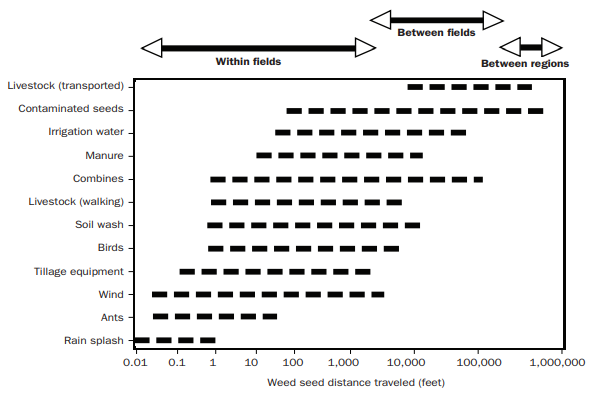
FIGURE 1. Agricultural weed seeds can travel over a range of distances, depending on the method of transport and the weed species. Adapted from Mohler (2001).
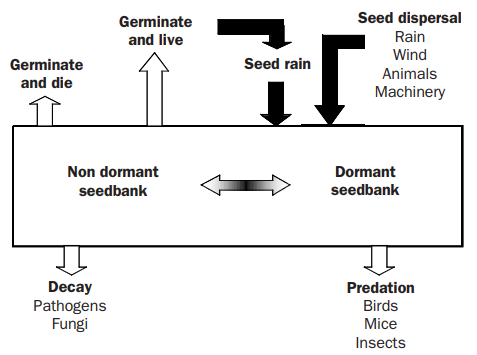
FIGURE 2. Fate of weed seeds. Inputs to the seedbank are shown with black arrows and losses with white arrows.
How do management practices affect weed seed distribution in the soil profile?
Weed seeds disperse both horizontally and vertically in the soil profile. While the horizontal distribution of weed seeds in the seedbank generally follows the direction of crop rows, type of tillage is the main factor determining the vertical distribution of weed seeds within the soil profile. In plowed fields, the majority of weed seeds are buried four to six inches below the surface. Under reduced tillage systems such as chisel plowing, approximately 80 to 90 percent of the weed seeds are distributed in the top four inches of the soil profile. In no-till fields, the majority of weed seeds remain at or near the soil surface. Although very few studies have assessed the affect of tillage systems on the vertical distribution of weed seeds in different soil types, evidence exists that soil characteristics influence weed seed distribution (Figure 3).
Understanding the impact of management practices on the vertical distribution of seeds is important as it can help us predict weed emergence patterns. For example, in most soils small-seeded weeds such as kochia, Canada thistle and common lambsquarters germinate at very shallow depths (less than ½ inch). Large seeded weeds such as common sunflower have more seed reserves and may germinate from deeper depths.
How long does weed seed persist in the seedbank?
Seed longevity in the soil depends on the interaction of many factors including the intrinsic dormancy of the seed population, the environmental conditions (e.g. light, temperature, moisture) and biological processes (e.g. predation, allelopathy). Understanding how management practices or environmental conditions modify the residence time of viable seeds can help producers to minimize future weed problems. For example, tillage enhances seed longevity as weed seed usually remain viable longer if they are buried. On the other hand, no-till reduces seed persistence by exposing them to predators and pathogens.
Although research has shown that agricultural weed seeds of some species may remain viable for several years, most weed seeds will either germinate or die shortly after being dispersed from the parent plant (Table 1). In a field study conducted near Bozeman, wild oat seeds were incorporated into the top four inches of a wheat-fallow field and approximately 80 percent of them died during the first winter (Figure 4).
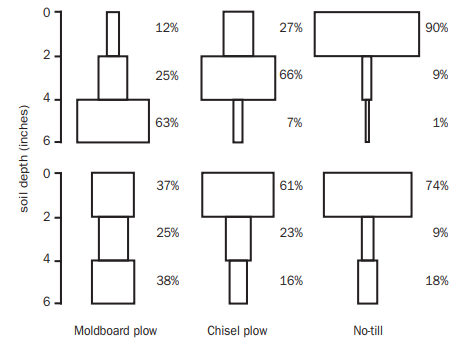
FIGURE 3. Vertical distribution of weed seeds in a loamy sand soil (top) and a silty loam soil (bottom). Adapted from Clements et al. (1996).
Why is it important to prevent weed seed production?
Limiting current contributions to the weed seedbank is the best approach to ease future weed management. Over a five- year period in Nebraska, broadleaf and grass weed seedbank was reduced to 5 percent of the original density when weeds were not allowed to produce seeds. However, in the sixth year, weeds were not controlled and the seedbank density increased to 90 percent of the original level (Burnside et al., 1984)!
In a six-year study conducted in Canada, Beckie and collaborators (2005) observed that when standard weed management practices were combined with weed seed shed prevention, weed patches expanded in size by 35 percent. However, when only standard weed management approaches were applied, weed patch expansion reached 330 percent (Figure 5).
These studies illustrate three important points. First, seedbank abundance declines rapidly when no new weed seed are allowed to enter to soil. Second, management failures can translate into a rapid increase in weed seedbank abundance. Finally, preventing weed seed production not only helps reducing weed seedbanks, it prevents the spread of weeds across the field. Therefore, efforts should be made every year to reduce seed production and weed seedbank abundance as a few seeds are capable of infesting the fields.
| TABLE 1. Number of years required for 50 percent and 99 percent reduction in seed number in the seedbank of ten common agricultural weeds. Adapted from Davis et al. (2005). | ||
| Years required for 50% reduction | Years required for 99% reduction | |
| Common lambsquarters (Chenopodium album) | 12 | 78 |
| Field pennycress (Thlaspi arvense) | 6 | 38 |
| Common cocklebur (Xanthium strumarium) | 6 | 37 |
| Yellow foxtail (Setaria glauca) | 5 | 30 |
| Prostrate knotweed (Polygonum aviculare) | 4 | 30 |
| Shepherd’s purse (Capsella bursa-pastoris) | 3 | 11 |
| Giant foxtail (Setaria faberi) | less than 1 | 5 |
| Common sunflower (Helianthus annuus) | less than ½ | 2 |
| Kochia (Kochia scoparia) | less than ½ | 2 |
Managing the weed seedbank
The reproductive potential of agricultural weeds coupled with the persistence of weed seeds in the seedbank indicates that management strategies should not only focus on minimizing weed density and yield reductions, they should also include approaches to minimize weed seedbanks.
The study of weed seedbank composition and dynamics is a relatively new concept in weed science. Still, several management practices can be implemented to deplete the seedbank reservoir.
Prevention. The most efficient approach to reduce weed seedbanks is to not allow weeds to set seed in the field. Care should be taken to avoid bringing new weed seeds into a field through irrigation, equipment or animals. This can be achieved by screening irrigation water, washing equipment before bringing it into the field and keeping grazing animals in quarantine before moving them from a weedy field to a clean one.
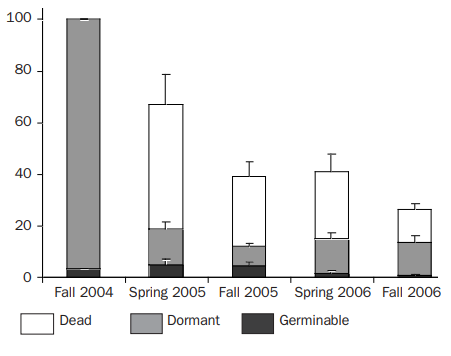
FIGURE 4. Wild oat seedbank dynamics. Seeds were mixed within the first 4 inches of the soil in October 2004 in a wheat-fallow field. Soil samples were obtained in early spring and late fall of 2005 and 2006. Wild oat seeds were ex- tracted from the soil samples and classified as dead, alive but dormant and germinable. Adapted from Harbuck (2007).
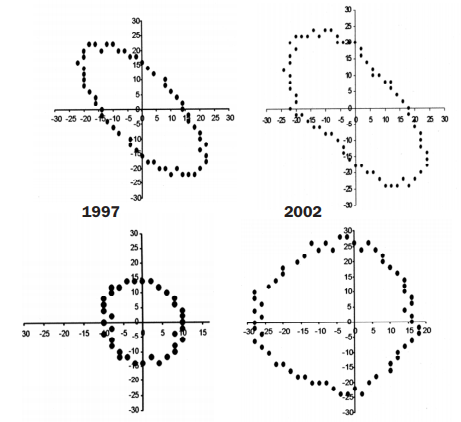
FIGURE 5. Weed patch expansion can be minimized by pre- venting weed seed inputs into the seedbank. During a five year period, a weed patch expanded 35 percent in size when standard weed management practices were combined with efforts to prevent seed production (top). During the same period, a weed patch expanded 330 percent in size when only standard weed management practices were applied (bottom). Adapted from Beckie et al. (2005).
Reduction. Reduction not only minimizes future weed problems, it also reduces the speed at which weed patches expand across crop fields. Increasing crop interference by increasing seeding rate and filling empty niches with cover crops helps minimize weed seed inputs into the seedbank. Other approaches include mowing weeds prior to seed production and controlling weeds with herbicides or cultivation.
Seed longevity. While burying weed seeds by tilling increases the longevity of the seeds in the seedbank, leaving weed seeds on the soil surface exposes them to predation, reducing their abundance in the seedbank.
Rotation. Rotation can cause a shift in weed species composition. Knowledge of theses shifts can help in changing the composition of the weed seedbank from undesirable to easy-to-manage species.
Manure. Composting manure reduces the viability of weed seeds, minimizing weed seed inputs into the seedbank.
References
Beckie, H., L.M. Hall, and B. Schuba. 2005. Patch management of herbicide-resistant wild oat (Avena fatua). Weed Technology 19:697-705.
Burnside, O.C., R.G. Wilson, G.A. Wicks, F.W. Roeth, and R.S. Moomaw. 1986. Weed seed decline and buildup under various corn management systems in Nebraska. Agronomy Journal 78: 451-454.
Clements, D.R., D.L. Benoit, and C.J. Swanton. 1996. Tillage effects on weed seed return and seedbank composition. Weed Science 44: 314-322.
Davis, A., K. A. Renner, C. Sprague, L. Dyer, and D. Mutch. 2005. Integrated Weed Management “One Year’s Seeding…” Extension Bulletin E-2931. East Lansing, MI. Michigan State University.
Forcella, F., R.G. Wilson, K.A. Renner, J. Dekker, R.G. Harvey, D.A. Alm, D.D. Buhler, and J. Cardina. 1992. Weed seedbanks of the United States Corn Belt - magnitude, variation, emergence, and application. Weed Science 40:636-644.
Harbuck, K.Z. 2007. Weed seedbank dynamics and composition of Northern Great Plains cropping systems. Montana State University MS thesis.
Mohler, C.L. 2001. Weed life history: identifying vulnerabilities. Pp. 40-98 in M. Liebman, C.L. Mohler, and C.P. Staver (eds.). Ecological Management of Agricultural Weeds. Cambridge, U.K.: Cambridge University Press.
For further information on Integrated Weed Management (IWM) read MSU Extension MontGuide Integrated Strategies for Managing Agricultural Weeds: Making Dropping Systems Less Susceptible to Weed Colonization and Establishment (MT200601AG) that is available from your local Extension office.
Did you know? Insects, birds, and rodents are your allies. Many studies have shown they can eat large quantities of weed seeds before (predispersal) or after (postdispersal) being shed from the parent plant. Combining field data with simulation models, Westerman and collaborators (2005) showed that herbicides and cultivation could be substantially reduced in a diverse crop rotation that had high levels of seed predation, compared to a simple rotation with lower rates of predation.

